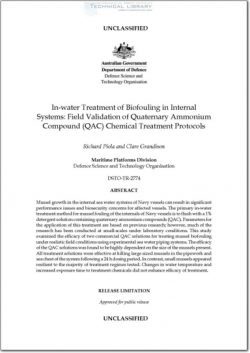DSTO-TR-2774

- Version
- 204 Downloads
- 1.31 MB File Size
- 1 File Count
- August 10, 2016 Create Date
- August 10, 2016 Last Updated
In-water Treatment of Biofouling in Internal Systems; Field Validation of Quaternary Ammonium Compound (QAC) Chemical Treatment Protocols

Ship internal sea water systems have long been recognised as high risk mechanisms for
non-indigenous species (NIS) transfer due to their propensity to readily accumulate and
shelter sessile and mobile marine species. Fouling in sea chests and sea water pipework is
also an operational issue for marine engineers, as it restricts and changes water flow
regimes to essential vessel systems and may enhance biocorrosion. In the past five years,
there have been ten instances of unwanted mussel biofouling on RAN vessels, five of
which involved sea chests and / or internal sea water system fouling.
While dry docking vessels is the surest method of effectively minimising biosecurity risks,
the process is expensive, time consuming and has the potential to impact operational
availability of vessels. In contrast, in—water treatment of vessel biofouling is significantly
more cost effective. Non-oxidising disinfectant / sanitiser solutions containing quaternary
ammonium compounds (QACs) are a recognised method for treating biofouling in sea
water pipework systems.
The overall aim of the present study was to field—validate previous DSTO research
assessing the usage parameters of QAC solutions for the control of mussels occurring in
vessel sea water systems, using a replica experimental piping system. The study examined
the effectiveness of two commercially available QAC disinfectants formulations, ’Conquest
TGA ’ and ’Quutsan ’, in killing the southern Australian blue mussel Mytilus gulloprovinciulis
plunulutus. Conquest is currently recommended to the RAN for emergency biosecurity
response treatment and the use of Quqtsun as a biosecurity response agent has been
previously studied by DSTO, NT Fisheries and Neil and Stafford [1, 2]. These agents were
therefore chosen for further examination during this study.
This study showed that the efficacy of two commercially available QAC formulations
(Conquest and Quutsun) in treating mussel biofouling of sea water systems was highly
dependent on the size of the mussels present. Treatment solutions of both Quutsun and
Conquest appeared very effective at killing large sized (50 — 90 mm) mussels in the
pipework and sea chest environments following a 24 h dosing period.
| File | Action |
|---|---|
| DSTO-TR-2774 In-water Treatment of Biofouling in Internal Systems; Field Validation of Quaternary Ammonium Compound (QAC) Chemical Treatment Protocols.pdf | Download |

Comment On This Post